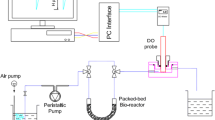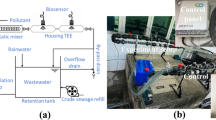Abstract
Although the long incubation time of biochemical oxygen demand (BOD7) measurements has been addressed by the use of microbial biosensors, the resulting sensor-BOD values gained from the measurements with specific industrial wastewaters still underestimates the BOD value of such samples. This research aims to provide fast and more accurate BOD measurements in the dairy wastewater samples. Unlike municipal wastewater, wastewater from the dairy industry contains many substrates that are not easily accessible to a majority of microorganisms. Therefore, a bacterial culture, Microbacterium phyllosphaerae, isolated from dairy wastewater was used to construct a semi-specific microbial biosensor. A universal microbial biosensor based on Pseudomonas fluorescens, which has a wide substrate spectrum but is nonspecific to dairy wastewater, was used as a comparison. BOD biosensors were calibrated with OECD synthetic wastewater, and experiments with different synthetic and actual wastewater samples were carried out. Results show that the semi-specific M. phyllosphaerae-based microbial biosensor is more sensitive towards wastewaters that contain milk derivates and butter whey than the P. fluorescens-based biosensor. Although the M. phyllosphaerae biosensor underestimates the BOD7 value of actual dairy wastewaters by 25–32 %, this bacterial culture is more suitable for BOD monitoring in dairy wastewater than P. fluorescens, which underestimated the same samples by 46–61 %.




Similar content being viewed by others
References
APHA (1985) Standard methods for examination of water and wastewater, 16th edn. American Public Health Association, Washington D.C, pp 525–531
Chee G-J, Nomura Y, Ikebukuro K, Karube I (2007) Stopped-flow system with ozonizer for the estimation of low biochemical oxygen demand in environmental samples. Biosens Bioelectron 22:3092–3098
D’Souza SF (2001) Microbial biosensors. Biosens Bioelectron 16:337–353
Dhall P, Kumar A, Joshi A, Saxsena TK, Manoharan A, Makhijani SD, Kumar R (2008) Quick and reliable estimation of BOD load of beverage industrial wastewater by developing BOD biosensor. Sensors Actuators B 133:478–483
Fang HHP, Yu HQ (2000) Effect of HRT on mesophilic acidogenesis of dairy wastewater. J Environ Eng 126:1145–1148
Janczukowicz W, Zielinski M, Debowski M (2008) Biodegradability evaluation of dairy effluents originated in selected sections of dairy production. Bioresour Technol 99:4199–4205
Kara S, Keskinler B, Erhan E (2009) A novel microbial BOD biosensor developed by the immobilization of P. syringae in micro-cellular polymers. J Chem Technol Biotechnol 84:511–518
Karube I, Nakanishi K (1994) Immobilized cells used for detection and analysis. Curr Opin Biotechnol 5:54–59
Kasapgil B, Anderson GK, Ince O (1994) An investigation into the pretreatment of dairy wastewater prior to aerobic biological treatment. Water Sci Technol 29:205–212
Kim MN, Park KH (2001) Klebsiella BOD sensor. Sensors Actuators B 80:9–14
Liu J, Mattiasson B (2002) Microbial BOD sensors for wastewater analysis. Water Res 36:3786–3802
Mello LD, Kubota LT (2002) Review of the use of biosensors as analytical tools in the food and drink industries. Food Chem 77:237–256
OECD (1984) Activated sludge, respiration inhibition test. OECD guidelines for the testing of chemicals. OECD, Paris
Olaniran AO, Motebejane RM, Pillay B (2008) Bacterial biosensors for rapid and effective monitoring of biodegradation of organic pollutants in wastewater effluents. J Environ Monit 10:889–893
Omil F, Garrido JM, Arrojo B, Méndez R (2003) Anaerobic filter reactor performance for the treatment of complex dairy wastewater at industrial scale. Water Res 37:4099–4108
Ozturk I, Eroglu V, Ubay G, Demir I (1993) Hybrid upflow anaerobic sludge blanket reactor (HUASBR) treatment of dairy effluents. Water Sci Technol 28:77–85
Perle M, Kimchie S, Shelef G (1995) Some biochemical aspects of the anaerobic degradation of dairy wastewater. Water Res 29:1549–1554
Rastogi S, Rathee P, Saxena TK, Mehra NK, Kumar R (2003) BOD analysis of industrial effluents: 5 days to 5 min. Curr Appl Phys 3:191–194
Raud M, Linde E, Kibena E, Velling S, Tenno T, Talpsep E, Kikas T (2010) Semi-specific biosensors for measuring BOD in dairy wastewater. J Chem Technol Biotechnol 85:957–961
Raud M, Tenno T, Jõgi E, Kikas T (2012a) Comparative study of semi-specific Aeromonas hydrophila and universal Pseudomonas fluorescens biosensors for BOD measurements in meat industry wastewaters. Enzym Microb Technol 50:221–226
Raud M, Tutt M, Jõgi E, Kikas T (2012b) BOD biosensors for pulp and paper industry wastewater analysis. Environ Sci Pollut Res 19:3039–3045
Raudkivi K, Tutt M, Talpsep E, Kikas T (2008) Pseudomonas putida P67.2 and Pseudomonas fluorescens P75 based microbial sensors for biochemical oxygen demand (BOD) measurements in phenolic wastewaters of oil shale industry. Oil Shale 25:376–386
Reshetilov AN (2005) Microbial, enzymatic, and immune biosensors for ecological monitoring and control of biotechnological processes. Appl Biochem Microbiol 41:442–449
Rico Gutierrez JL, Garcia Encina PA, Fdz-Polanco F (1991) Anaerobic treatment of cheese-production wastewater using a UASB reactor. Bioresour Technol 37:271–276
Sakaguchi T, Kitagawa K, Ando T, Murakami Y, Morita Y, Yamamura A, Yokoyama K, Tamiya E (2003) A rapid BOD sensing system using luminescent recombinants of Echerichia coli. Biosens Bioelectron 19:115–121
Salmerón-Alcocer A, Ruiz-Ordaz N, Juárez-Ramírez C, Galíndez-Mayer J (2007) Continuous biodegradation of single and mixed chlorophenols by a mixed microbial culture constituted by Burkholderia sp., Microbacterium phyllosphaerae, and Candida tropicalis. Biochem Eng J 37:201–2011
Schwarzenbeck N, Borges JM, Wilderer PA (2005) Treatment of dairy effluents in an aerobic granular sludge sequencing batch reactor. Appl Microbiol Biotechnol 66:711–718
SIS (1979) Water analysis—determination of biochemical oxygen demand, BOD, of water—dilution method. The Swedish Standards Institute, Stockholm, pp 1–9
Su L, Jia W, Hou C, Lei Y (2011) Microbial biosensors: a review. Biosens Bioelectron 26:1788–1799
Tan TC, Lim EWC (2005) Thermally killed cells of complex microbial culture for biosensor measurement of BOD of wastewater. Sensors Actuators B 107:546–551
Tanaka H, Nakamura E, Minamiyama Y, Toyoda T (1994) BOD biosensor for secondary effluent from wastewater treatment plants. Water Sci Technol 30:215–227
Thassitou PK, Arvanitoyannis IS (2001) Bioremediation: a novel approach to food waste management. Trends Food Sci Technol 12:185–196
Thévenot DR, Toth K, Durst RA, Wilson GS (2001) Electrochemical biosensors: recommended definitions and classification. Biosens Bioelectron 16:121–131
Vourch M, Balannec B, Chaufer B, Dorange G (2008) Treatment of dairy industry wastewater by reverse osmosis for water reuse. Desalination 219:190–202
Wang J, Zhang Y, Wang Y, Xu R, Sun Z, Jie Z (2010) An innovative reactor-type biosensor for BOD rapid measurement. Biosens Bioelectron 25:1705–1709
Xu X, Ying Y (2011) Microbial biosensors for environmental monitoring and food analysis. Food Rev Int 27:300–329
Acknowledgments
We gratefully acknowledge the support of Estonian Science Foundation (ETF 9136) and the target-financed project of the Estonian Ministry of Education and Research NoSF0180135s08 named “Processes in macro- and microheterogeneous and nanoscale systems and related technological applications.”
Author information
Authors and Affiliations
Corresponding author
Additional information
Responsible editor: Philippe Garrigues
Rights and permissions
About this article
Cite this article
Kibena, E., Raud, M., Jõgi, E. et al. Semi-specific Microbacterium phyllosphaerae-based microbial sensor for biochemical oxygen demand measurements in dairy wastewater. Environ Sci Pollut Res 20, 2492–2498 (2013). https://doi.org/10.1007/s11356-012-1166-8
Received:
Accepted:
Published:
Issue Date:
DOI: https://doi.org/10.1007/s11356-012-1166-8




